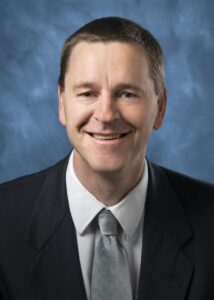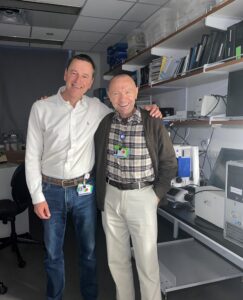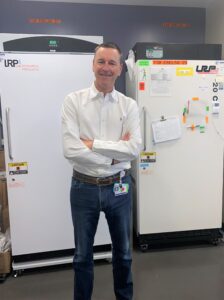Dr. Dan Theodorescu, Surgeon, Researcher, Cancer Center Director
 Dan Theodorescu, MD, PhD, Director of Cedars-Sinai Cancer Center in Los Angeles immigrated to Canada from Bucharest, Romania as a young boy. Both of his parents were “math people,” his father an internationally renowned mathematics professor. Theodorescu was named after his paternal grandfather, who was an eminent physician in Bucharest. He started school in Quebec, speaking neither French nor English. At age 10, he lost a favorite aunt to cancer and decided to become a doctor to help cure cancer. He read many books and found medical role models within those pages. Paul Erlich was inspiring to him as a doctor and researcher.
Dan Theodorescu, MD, PhD, Director of Cedars-Sinai Cancer Center in Los Angeles immigrated to Canada from Bucharest, Romania as a young boy. Both of his parents were “math people,” his father an internationally renowned mathematics professor. Theodorescu was named after his paternal grandfather, who was an eminent physician in Bucharest. He started school in Quebec, speaking neither French nor English. At age 10, he lost a favorite aunt to cancer and decided to become a doctor to help cure cancer. He read many books and found medical role models within those pages. Paul Erlich was inspiring to him as a doctor and researcher.
Originally, Theodorescu wanted to be a pediatric oncologist and a researcher, but he always liked working with his hands. When he worked with Dr. Bob Filler, a pediatric surgeon, he realized he also loved the operating room and surgery. There were many nay-sayers who told him that he could not do research and have a surgical practice at the same time. Dr. Follman who became a mentor and role model, encouraged him to pursue his dreams of a career in cancer research and surgery.
Dr. Theodorescu completed his medical training and his PhD degree in Toronto and a clinical fellowship at the Memorial Sloan-Kettering Cancer Center in New York. He began his academic career at the University of Virginia where he obtained his first National Cancer Institute grant. This grant has been continuously funded since that time and has recently been renewed for another 5 years. Pursuing his own dreams and also helping others pursue their dreams has always been important to Dr. Theodorescu. Throughout his career, he has mentored and advocated for candidates for leadership positions and awards.
Dr. Theodorescu left the University of Virginia to lead the NCI-designated Comprehensive Cancer Center at the University of Colorado in Denver while continuing his own research. At Colorado, Dr. Theodorescu was named Distinguished Professor, the only surgeon to have been granted this award. He is the author of more than 300 publications, serves on numerous journal editorial boards, and has won many significant awards in medicine. Theodorescu is a founding co-editor in chief of Bladder Cancer, the first journal focused on this disease, and an elected member of the American Society for Clinical Investigation (ASCI), Association of American Physicians (AAP), the American Association of Genitourinary Surgeons (AAGUS), the American Surgical Association (ASA), and the National Academy of Medicine (NAM). He is an Honorary Fellow of the American Association for the Advancement of Science (AAAS).
In 2018, he became the Director of the Cedars-Sinai Cancer Center, which also encompasses the Samuel Oschin Comprehensive Cancer Institute and Clinical Center. He has combined his interests and dreams in surgical practice, cancer research, supporting diversity, and the careers and practices of other doctors and researchers.
Cedars-Sinai is a large, high-quality provider of cancer care. It established the BRCA Center of Excellence and Research Program in 2021 to meet patient needs. BRCA mutations are commonly associated with an increased risk of ovarian, breast, pancreatic, and prostate cancers. Of breast cancer cases, 5-10% are attributed to BRCA mutations. Women of Ashkenazi Jewish heritage have the greatest risk for carrying BRCA mutations (1 in 40). With normal BRCA genes, there is a 12% chance of developing breast cancer by age 70. In individuals having a pathogenic mutation of BRCA2, there is a 45% chance, and with a mutated BRCA1 gene, there is a 55-65% chance of developing breast cancer by age 70.
Many years ago, Gilda Radner, a famous comedian married to Gene Wilder, died of BRCA-related ovarian cancer at a young age. She endowed a Breast and Ovarian tissue repository at Cedars-Sinai. With new knowledge of the impact of BRCA mutations, this foundation is expanding to include other BRCA cancers. For example, in the general population, 2.2% of men aged 40-59 years are diagnosed with prostate cancer, and 13.7% of men aged 60-79 years. Prostate cancer is detected in 21% of male carriers of pathogenic BRCA1 mutations by 75 years of age, and 29% by age 85. For BRCA2 carriers the rate is even higher; 27% and 60%, and the tumors are far more aggressive. Normally, individuals have 2 normal copies of the BRCA genes. Pathogenic mutation carriers are born with 1 copy knocked out. The essential question is what is the second hit that leads to cancer? The quest for the holy grail is to be able to determine which individuals with BRCA germline mutations will develop cancer and when and what can be done to delay or eliminate the second hit? The ability to predict this would dramatically change patient management.

At Cedars-Sinai, Dr. Theodorescu collaborates with Dr. Clive Svendsen, Director of the Cedars-Sinai
Regenerative Medicine Institute. Svendsen’s passion for asking questions led to a career in neuroscience and stem cell science. He completed undergraduate work at Harvard and his PhD at Cambridge. His focus includes developing ways to use stem cells to both model and treat human diseases. Like cancer, many neurological diseases are genetic in origin. Dr. Svendsen and his neuroscience research colleagues have developed and adapted cutting–edge molecular genetic techniques that have not yet been widely applied to cancer research. Dr. Theodorescu and he have teamed up to bridge that gap.

Mutations or breakages in DNA cause cancer and drive growth and disease progression. The Svendsen-Theodorescu team has adapted new neuroscience techniques to induce pluripotent stem cells, called iPSCs (a cell that is able to develop into many different types of cells or tissues in the body) to advance research in ovarian and other cancers. It is now possible to generate BRCA1 cancer in a petri dish before the patient gets the disease. These advances in research and technology may allow physicians to predict how serious cancer will be or when it may start, which, in turn, could help make decisions on screening and prevention approaches. Additionally, their disease model may work for BRCA2 and other types of cancer, including prostate cancer.

Recently, Dr. Catalona invited Dr. Theodorescu and Dr. Clive Svendsen to present their work at a Urological Research Foundation Board meeting. This exciting research on the horizon could develop biomarkers to determine which men with BRCA1 or BRCA2 mutations will get prostate cancer. It could be possible to generate induced pluripotent stem cells from prostate cancer patients with pathogenic BRCA mutations and in those with normal BRCA genes. Researchers could use the new CRISPR technology to identify which other mutations act with the BRCA mutations to promote cancer formation to identify molecular pathways allowing cancer growth in BRCA mutated stem cells. This research has the potential to predict which patients will get cancer, effectively treat the cancer by exposing the stem cells to various drugs to determine which one will best treat the disease, and perhaps in the future, act to prevent the cancer from forming.
















